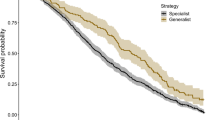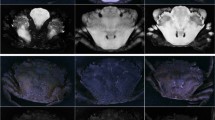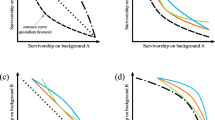Abstract
Camouflage is a key predation prevention mechanism. The most intuitive camouflage strategy is background matching, where a prey resembles the colour and pattern of its background. Spots (e.g. geometric ‘elements’ that constitute a pattern) are a common feature on the body of prey, but the effect of their size in relation to elements in the background is rarely examined in camouflage studies. Here, we test the survivorship of computer generated prey possessing patterns of elements grouped into eight size classes on backgrounds composed of elements of the same eight size classes. All 64 possible combinations were presented to human volunteers (n = 10) acting as ‘predators’ in a computer simulation. As hypothesised, prey survivorship was high when the prey-background element size difference was low. We found significant asymmetry, however, in survivorship pattern: prey morphs with elements larger than those of the backgrounds were harder to detect than morphs with elements smaller than those of the backgrounds. When testing for potential trade-offs we determined that, in a habitat consisting of an equal proportion of two backgrounds with a large element size difference between them, net survivorship of specialist prey morphs (same element size as one of the backgrounds) was similar to that of generalist morphs (intermediate element size). When the two backgrounds were less distinctive, i.e. reduced element size difference between the backgrounds, generalist prey morphs achieved significantly better net survivorship than specialists.
Similar content being viewed by others
References
Barbosa A, Mathger LM, Chubb C et al (2007) Disruptive coloration in cuttlefish: a visual perception mechanism that regulates ontogenetic adjustment of skin patterning. J Exp Biol 210:1139–1147
Barbosa A, Mathger LM, Buresch KC et al (2008) Cuttlefish camouflage: the effects of substrate contrast and size in evoking uniform, mottle or disruptive body patterns. Vis Res 48:1242–1253
Beatty CD, Bain RS, Sherratt TN (2005) The evolution of aggregation in profitable and unprofitable prey. Anim Behav 70:199–208
Chiao CC, Hanlon RT (2001a) Cuttlefish camouflage: visual perception of size, contrast and number of white squares on artificial checkerboard substrata initiates disruptive coloration. J Exp Biol 204:2119–2125
Chiao C-C, Hanlon RT (2001b) Cuttlefish cue visually on area: not shape or aspect ratio: of light objects in the substrate to produce disruptive body patterns for camouflage. Biol Bull 201:269
Cott HB (1940) Adaptive coloration in animals. Methuen and Co. Ltd, London
Cuthill IC, Szekely A (2009) Coincident disruptive coloration. Philos Trans R Soc B Biol Sci 364:489–496
Cuthill IC, Stevens M, Sheppard J et al (2005) Disruptive coloration and background pattern matching. Nature 434:72–74
Cuthill IC, Hiby E, Lloyd E (2006) The predation costs of symmetrical cryptic coloration. Proc R Soc B Biol Sci 273:1267–1271
Dimitrova M, Merilaita S (2010) Prey concealment: visual background complexity and prey contrast distribution. Behav Ecol 21:176–181
Dimitrova M, Merilaita S (2012) Prey pattern regularity and background complexity affect detectability of background-matching prey. Behav Ecol 23:384–390
Endler JA (1978) A predator’s view of animal color patterns. In: Hecht MK, Steere WC, Wallace B (eds) Evolutionary biology. Springer, Boston, pp 319–364
Endler JA (1980) Natural selection on color patterns in Poecilia reticulata. Evolution 34:76–91
Endler JA (1981) An overview of the relationships between mimicry and crypsis. Biol J Linn Soc 22:187–231
Endler JA (1984) Progressive background in moths, and a quantitative measure of crypsis. Biol J Linn Soc 22:187–231
Espinosa I, Cuthill IC (2014) Disruptive colouration and perceptual grouping. PLoS ONE 9(1):e87153
Farmer EW, Taylor RM (1980) Visual search through color displays: effects of target-background similarity and background uniformity. Percept Psychophys 27:267–272. doi:10.3758/BF03204265
Fraser S, Callahan A, Klassen D, Sherratt TN (2007) Empirical tests of the role of disruptive coloration in reducing detectability. Proc R Soc B Biol Sci 274:1325–1331
Gordon IE (1968) Interactions between items in visual search. J Exp Psychol 76:348–355
Hall JR, Cuthill IC, Baddeley R et al (2013) Camouflage, detection and identification of moving targets. Proc R Soc London B Biol Sci 280:1–7
Hanlon RT, Messenger JB (1988) Adaptive coloration in young cuttlefish (Sepia officinalis L.): the morphology and development of body patterns and their relation to behaviour. Philos Trans R Soc Lond B Biol Sci 320:437–487
Houston AI, Stevens M, Cuthill IC (2007) Animal camouflage: compromise or specialize in a 2 patch-type environment? Behav Ecol 18:769–775
Kang C, Stevens M, J-y Moon et al (2015) Camouflage through behavior in moths: the role of background matching and disruptive coloration. Behav Ecol 26:45–54
Karpestam E, Merilaita S, Forsman A (2013) Detection experiments with humans implicate visual predation as a driver of colour polymorphism dynamics in pygmy grasshoppers. BMC Ecol 13:17
Kiltie RA (1992) Tests of hypotheses on predation as a factor maintaining polymorphic melanism in coastal-plain fox squirrels (Sciurus niger L.). Biol J Linn Soc 45:17–37
King RB (1992) Lake Erie water snakes revisited: morph- and age-specific variation in relative crypsis. Evol Ecol 6:115–124
Merilaita S (1998) Crypsis through disruptive coloration in an isopod. Proc R Soc Lond B 265:1059–1064
Merilaita S (1999) Optimization of cryptic coloration in heterogeneous habitats. Biol J Linn Soc 67:151–161
Merilaita S (2003) Visual background complexity facilitates the evolution of camouflage. Evolution 57:1248–1254
Merilaita S, Dimitrova M (2014) Accuracy of background matching and prey detection: predation by blue tits indicates intense selection for highly matching prey colour pattern. Funct Ecol 28:1208–1215
Merilaita S, Lind J (2005) Background-matching and disruptive coloration, and the evolution of cryptic coloration. Proc R Soc B Biol Sci 272:665–670
Merilaita S, Stevens M (2011) Crypsis through background matching. In: Stevens M, Merilaita S (eds) Animal camouflage: mechanisms and function. Cambridge University Press, Cambridge, pp 17–33
Merilaita S, Lyytinen A, Mappes J (2001) Selection for cryptic coloration in a visually heterogeneous habitat. Proc R Soc B Biol Sci 268:1925–1929
Ruxton GD, Sherratt TN, Speed MP (2004) Avoiding attack: the evolutionary ecology of crypsis, warning signals and mimicry. Oxford University Press, Oxford
Schaefer HM, Stobbe N (2006) Disruptive coloration provides camouflage independent of background matching. Proc R Soc B Biol Sci 273:2427–2432
Sherratt TN, Pollitt D, Wilkinson DM (2007) The evolution of crypsis in replicating populations of web-based prey. Oikos 116:449–460
Stevens M, Merilaita S (2009a) Animal camouflage: current issues and new perspectives. Philos Trans R Soc B Biol Sci 364:423–427
Stevens M, Merilaita S (2009b) Defining disruptive coloration and distinguishing its functions. Philos Trans R Soc B Biol Sci 364:481–488
Stevens M, Merilaita S (2011) Animal camouflage: an introduction. In: Stevens M, Merilaita S (eds) Animal camouflage: mechanisms and function. Cambridge University Press, Cambridge
Stevens M, Cuthill IC, Windsor AMM, Walker HJ (2006) Disruptive contrast in animal camouflage. Proc R Soc B Biol Sci 273:2433–2438
Stevens M, Winney IS, Cantor A, Graham J (2009) Outline and surface disruption in animal camouflage. Proc R Soc B Biol Sci 276:781–786
Stevens M, Marshall KLA, Troscianko J et al (2013) Revealed by conspicuousness: distractive markings reduce camouflage. Behav Ecol 24:213–222
Todd PA (2009) Testing for camouflage using virtual prey and human “predators”. J Biol Educ 43:81–84
Todd PA, Phua H, Toh KB (2015) Interactions between background matching and disruptive colouration: experiments using human predators and virtual crabs. Curr Zool 61:718–728
Webster RJ (2015) Does disruptive camouflage conceal edges and features? Curr Zool 61:708–717
Webster RJ, Hassall C, Herdman CM et al (2013) Disruptive camouflage impairs object recognition. Biol Lett 9:20130501
Webster RJ, Godin J-GJ, Sherratt TN (2015) The role of body shape and edge characteristics on the concealment afforded by potentially disruptive marking. Anim Behav 104:197–202
Acknowledgements
We are grateful to all the NUS students who participated in the experiment and the members of the Experimental Marine Ecology Laboratory who provided support and input. We would also like to thank the reviewers for their constructive comments. This research was funded by Singapore’s Ministry of Education’s AcRF Tier 1 Grant Numbers R-154-000-414-133 and R-154-000-660-112.
Author information
Authors and Affiliations
Corresponding author
Rights and permissions
About this article
Cite this article
Toh, K.B., Todd, P. Camouflage that is spot on! Optimization of spot size in prey-background matching. Evol Ecol 31, 447–461 (2017). https://doi.org/10.1007/s10682-017-9886-3
Received:
Accepted:
Published:
Issue Date:
DOI: https://doi.org/10.1007/s10682-017-9886-3
Keywords
Profiles
- Kok Ben Toh View author profile










